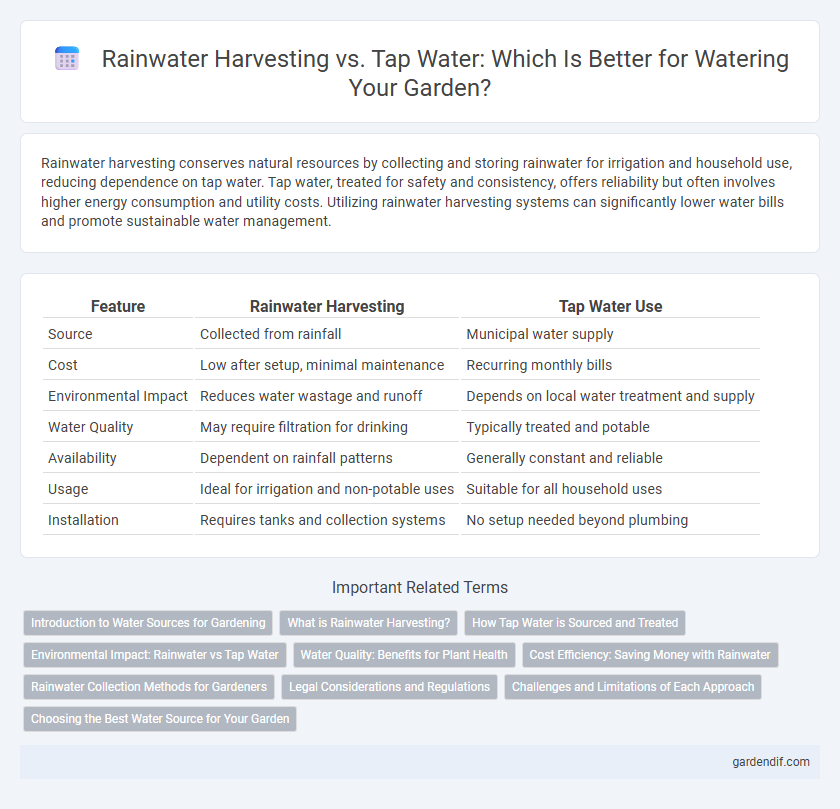
Rainwater harvesting vs Tap water use Illustration
Rainwater harvesting conserves natural resources by collecting and storing rainwater for irrigation and household use, reducing dependence on tap water. Tap water, treated for safety and consistency, offers reliability but often involves higher energy consumption and utility costs. Utilizing rainwater harvesting systems can significantly lower water bills and promote sustainable water management.
Table of Comparison
| Feature | Rainwater Harvesting | Tap Water Use |
|---|---|---|
| Source | Collected from rainfall | Municipal water supply |
| Cost | Low after setup, minimal maintenance | Recurring monthly bills |
| Environmental Impact | Reduces water wastage and runoff | Depends on local water treatment and supply |
| Water Quality | May require filtration for drinking | Typically treated and potable |
| Availability | Dependent on rainfall patterns | Generally constant and reliable |
| Usage | Ideal for irrigation and non-potable uses | Suitable for all household uses |
| Installation | Requires tanks and collection systems | No setup needed beyond plumbing |
Introduction to Water Sources for Gardening
Rainwater harvesting captures and stores natural precipitation, providing a sustainable and cost-effective water source for gardening. Tap water, sourced from municipal supplies, offers a reliable and regulated option but may contain chemicals like chlorine and fluoride that can affect soil health. Utilizing rainwater reduces dependence on treated water, conserves resources, and supports healthier plant growth through natural mineral content.
What is Rainwater Harvesting?
Rainwater harvesting is the process of collecting and storing rainwater from roofs or other surfaces for later use, reducing reliance on municipal tap water. This sustainable method conserves water by capturing runoff, which can be filtered and utilized for irrigation, gardening, and non-potable household needs. Implementing rainwater harvesting systems helps decrease water bills and mitigates the strain on local water supply networks during droughts.
How Tap Water is Sourced and Treated
Tap water is typically sourced from surface water bodies like rivers, lakes, or reservoirs, and groundwater from aquifers, undergoing rigorous treatment including filtration, sedimentation, chlorination, and fluoridation to ensure safety and potability according to regulatory standards. Treatment plants remove contaminants, pathogens, and chemical impurities to provide clean, reliable drinking water distributed through municipal piping systems. This extensive process contrasts with rainwater harvesting, which collects and stores rainwater with minimal treatment mainly for non-potable uses.
Environmental Impact: Rainwater vs Tap Water
Rainwater harvesting significantly reduces environmental impact by conserving municipal water supplies and lowering energy consumption associated with water treatment and distribution. Tap water use often involves higher carbon footprints due to extensive infrastructure, chemical treatment, and pumping processes. Utilizing rainwater for irrigation minimizes runoff, decreases demand on freshwater ecosystems, and supports sustainable water management practices.
Water Quality: Benefits for Plant Health
Rainwater harvesting provides plants with naturally soft, unchlorinated water rich in essential nutrients, promoting healthier growth and reducing the risk of chemical damage common in tap water. Tap water often contains chlorine, fluoride, and other additives that can accumulate in soil and harm beneficial microorganisms vital for plant health. Using harvested rainwater enhances soil quality and supports sustainable gardening by delivering pure hydration directly from the environment.
Cost Efficiency: Saving Money with Rainwater
Rainwater harvesting significantly reduces water bills by providing a free, sustainable source of water for gardening and irrigation. Unlike tap water, which incurs ongoing utility costs, rainwater systems require a one-time investment in collection and storage infrastructure. Long-term savings are amplified by decreased dependence on municipal water supplies, making rainwater harvesting a cost-efficient solution for sustainable watering.
Rainwater Collection Methods for Gardeners
Rainwater harvesting methods for gardeners include rooftop collection systems directing water into storage barrels or underground tanks, minimizing reliance on tap water and reducing utility bills. Techniques such as using rain chains, gutters, and first-flush diverters improve water quality by filtering debris before storage. Implementing rainwater collection promotes sustainable gardening by conserving potable water and supporting plant health through natural, chemical-free water sources.
Legal Considerations and Regulations
Rainwater harvesting is subject to varying legal considerations depending on jurisdiction, with some regions requiring permits while others encourage its use to reduce reliance on municipal tap water. Tap water use is regulated by strict local and national standards ensuring quality and safety, often governed by environmental protection agencies. Understanding and complying with these regulations is essential for water management strategies, as non-compliance can lead to penalties or restrictions.
Challenges and Limitations of Each Approach
Rainwater harvesting faces challenges such as limited storage capacity, seasonal variability, and potential contamination risks requiring filtration and maintenance. Tap water use involves limitations including higher costs, reliance on centralized infrastructure, and environmental concerns due to excessive water extraction and chemical treatments. Both approaches require careful management to balance efficiency, sustainability, and water quality for effective irrigation and household use.
Choosing the Best Water Source for Your Garden
Rainwater harvesting captures natural precipitation, reducing reliance on tap water and promoting sustainability by conserving potable water supplies. Tap water provides a reliable and easily accessible option, but its treatment chemicals and higher cost can impact plant health and garden expenses. Selecting rainwater supports eco-friendly gardening by minimizing environmental impact and improving soil quality through naturally soft water.
Rainwater harvesting vs Tap water use Infographic

 gardendif.com
gardendif.com